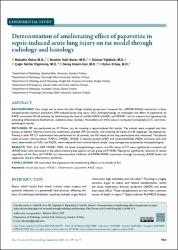Demonstration of ameliorating effect of papaverine in sepsis-induced acute lung injury on rat model through radiology and histology

Göster/
Tarih
2023Yazar
Özkul, BahattinSever, İbrahim Halil
Yiğittürk, Gürkan
Elgörmüş, Çağrı Serdar
Gür, Seray Gizem
Erbaş, Oytun
Üst veri
Tüm öğe kaydını gösterKünye
Özkul B, Sever İH, Yiğittürk G, Elgörmüş ÇS, Gür SG, Erbaş O. Demonstration of ameliorating effect of papaverine in sepsis-induced acute lung injury on rat model through radiology and histology. Ulus Travma Acil Cerrahi Derg. 2023 Sep;29(9):963-971. English. doi: 10.14744/tjtes.2023.73580. PMID: 37681716.Özet
Background: Our target was to show the role of high mobility group box-1/receptor for (HMGB1/RAGE) interaction in feces intraperitoneal injection procedure (FIP)-induced acute lung injury (ALI) pathophysiology, to investigate the effect of papaverine on RAGE associated NF-κB pathway by determining the level of soluble RAGE (sRAGE) and HMGB1, and to support this hypothesis by evaluating inflammatory biochemical, oxidative stress markers, Hounsfield unit (HU) value in computed tomography (CT), and histo-pathological results.
Methods: FIP was performed on 37 Wistar rats for creating a sepsis-induced ALI model. The animals were assigned into four groups as follows: Normal control (no treatment), placebo (FIP and saline), and receiving 20 mg/kg and 40 mg/kg per day papaverine. Twenty h after FIP, CT examination was performed for all animals, and HU value of the lung parenchyma was measured. The plasma levels of tumor necrosis factor (TNF)-α, HMGB1, sRAGE, C-reactive protein (CRP) and malondialdehyde (MDA), and lactic acid (LA) were determined and PaO2 and PaCO2 were measured from arterial blood sample. Lung damage was assessed by histopathological.
Results: TNF-, IL-6, CRP, HMGB1, MDA, LA levels, histopathologic scores, and HU values of CT were significantly increased and sRAGE levels were decreased in the saline-treated group against normal group (all P<0.05). Papaverine significantly reversed all results regardless of the dose (all P<0.05) and demonstrated inhibition of HMGB1/RAGE interaction through increasing sRAGE levels and suppresses the pro-inflammatory cytokines.

















